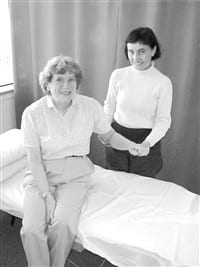CDH Prevents Infection, Pneumonia as Part of 100K Lives Campaign
NORTHAMPTON – Cooley Dickinson Hospital recently announced that after participating in the Institute for Healthcare Improvement’s (IHI) landmark 100,000 Lives Campaign for the past 18 months, CDH is dramatically improving how patients are cared for when they’re most at risk for infection, adverse outcomes and other complications.
Initially launched in December 2004, the 100,000 Lives Campaign is the first national campaign to promote saving a specified number of lives in hospitals by June 14, 2006 through the implementation of proven, evidence-based, practices and procedures.
“As one of the first hospitals to sign on to the IHI initiative, Cooley Dickinson Hospital readily adopted and continues to implement best practices that improve care for our patients,” said Craig Melin, president and CEO of the Northampton- based hospital. “By modifying these practices, we are preventing infections and cases of pneumonia, assembling life-saving teams to respond to code blue events and reconciling medications to prevent errors.”
The IHI designated CDH a Mentor Hospital for the prevention of central line infections. Given this status, says CDH Quality Director Donna Truesdell, RN, “CDH experts are available to coach and mentor other hospitals across the United States who are implementing the 100K Lives interventions.” IHI has designated nearly 100 U. S. hospitals as Mentor Hospitals.
Melin said that by adding staff to the organization’s quality department and participating in life-saving initiatives like the IHI’s 100,000 Lives Campaign, CDH is delivering consistent world-class care that exceeds established benchmarks. “We’ve committed a lot of resources to providing quality care. We’re tapping into our employees’ and physicians’ abilities to recognize opportunities for improvement. So far, we’re seeing impressive results.”
Melin cited the following examples of Cooley Dickinson’s outcomes and the subsequent results:
• Prevent patients who are receiving medicines and fluids through central lines from developing infections by following five steps, including proper hand washing and cleaning the patient’s skin with a type of soap called chlorhexidine. At CDH in 2002-2003, the hospital implemented best practices for preventing central line infections. As a result of these improvements, there has only been one central line infection in the ICU in more than three years. For these efforts, CDH has been named a Mentor Hospital by the IHI.
• Prevent patients on ventilators from developing pneumonia by following four steps, including raising the head of the patient’s bed between 30 and 45 degrees. As a result of the implementation of these practices, there were 297days between ventilator-associated pneumonias.
• Prevent medication errors by ensuring that accurate and continually updated lists of patients’ medications are referenced during their hospital stay, particularly at transition points. CDH developed a yellow wallet card to assist the public in carrying a current list of medications with them at all times. This is a critical first step in preventing medication errors. Over the past 10 months CDH has reduced the number of potential medication errors by 50{06cf2b9696b159f874511d23dbc893eb1ac83014175ed30550cfff22781411e5}. Currently, CDH discharges patients with individualized physician-generated medication lists and a yellow wallet card.
• Activate a Rapid Response Team at the first sign that a patient’s condition is worsening and may lead to a more serious medical emergency. The implementation of the Rapid Response Team has resulted in a 21{06cf2b9696b159f874511d23dbc893eb1ac83014175ed30550cfff22781411e5} decrease in the number of “code blue” events.
• Prevent patients undergoing surgery from developing infections by following a series of steps, including the timely administration of antibiotics. CDH’s infection rate decreased by 15{06cf2b9696b159f874511d23dbc893eb1ac83014175ed30550cfff22781411e5} as these changes were implemented. Changes included antibiotic review, giving antibiotics within one hour of the incision and discontinuing antibiotics within 24 hours of surgery, and clipping hair at surgical site instead of shaving.
• Prevent patients from dying of heart attacks by delivering evidence-based care, including appropriate administration of aspirin to prevent blood clots and Beta blockers to prevent further heart attacks. CDH has built systems to ensure 100{06cf2b9696b159f874511d23dbc893eb1ac83014175ed30550cfff22781411e5} of heart attack patients receive best-practice care, which is designed to prevent deaths from heart attack. CDH provides aspirin within 24 hours and at discharge, encourages smoking cessation counseling for smokers and gives clot-busting drugs in less than 30 minutes.
The accomplishments of the 100,000 Lives Campaign nationally include the enrollment of more than 3,000 hospitals – comprising an estimated 85 percent of the acute care hospital beds in the country – and the creation of a national infrastructure of Campaign field offices that offer resources and support to participating hospitals throughout the US.
“Hospitals are not only demonstrating a dedication to saving lives during the 100,000 Lives Campaign,” said Dr. Donald Berwick, President and CEO of the IHI. They are also implementing important changes in health care delivery that will reduce preventable illness and death beyond the Campaign’s June 2006 deadline.”
Cooley Dickinson is a non-profit community hospital located in Northampton, Mass. Cooley Dickinson Hospital is also a member of the Dartmouth-Hitchcock Alliance. With colleagues at the Alliance, CDH has shared tools and expanded knowledge in the science of improvement; additionally, measures have been created to track our progress over time and in comparison with others. CDH aspires to be a model community hospital in the top tenth percentile nationwide for the quality of patient care.
The 3,000 hospitals participating in the Campaign are located in all 50 states and the District of Columbia. To learn more about the Campaign or to see a full list of participating hospitals (by state) visit www.ihi.org/campaign.


Comments are closed.